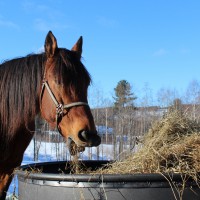Chew on hay or silage – does the eating behaviour change?

In this study horses eating behaviour on hay and silage diets have been examined with the help of five trotters in race training. They were fed hay and silage alone (supplemented with minerals and salt). The hay and the silage were from the same ley and were harvested the same day but wilted to different dry matter (DM) concentrations: hay 82% DM and silage 45% DM.
The horses were accustomed to both diets and were fed for 3 weeks with hay and silage each. At one occasion in both the hay and the silage period the horses were given 0.5 kg DM of the forage they were fed in that period. The number of chews per minute and the total eating time for the 0.5 kg DM were measured. The same measurements were carried out by the same person on the same horse on each diet and all measurements were done at the same time of the day.
A preference test was also carried out to see if the horses preferred the hay or the silage. In this test 1 kg DM of hay and silage were placed in each corner of the box in plastic tubs. The horses were observed during 15 minutes and once per minute which forage the horse was eating from was registered. To avoid the results being affected by a “favourite corner” in the box the test was repeated with reversed placement of the forages.
The chewing frequency, number of chews per minute, did not differ between the diets; the horses chewed the hay and the silage at the same pace (Table 1). But the total eating time differed between the forages; it took longer time for the horses to finish eating 0.5 kg DM silage compared to 0.5 kg DM hay (Table 1).
That it took longer time for the horses to finish eating the silage compared to the hay is probably due to that the silage contained more water and therefore is a larger volume to consume. In the preference test the horses chose silage instead of hay in 70% of the observations, so they seemed to prefer the silage ahead of the hay.
In conclusion there was no difference in chewing frequency between hay and silage but it took longer time for the horses to consume the same amount of silage DM as hay DM. The horses mainly chose silage over the drier forage hay.
Sara Muhonen, AgrD

